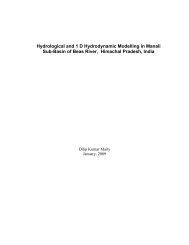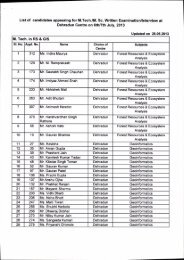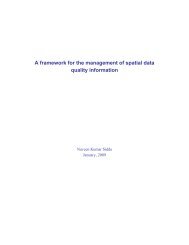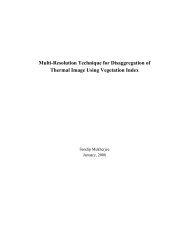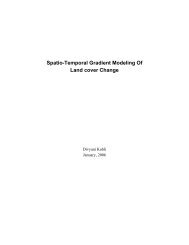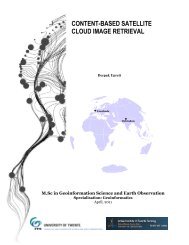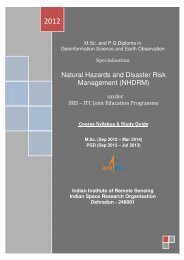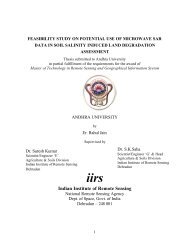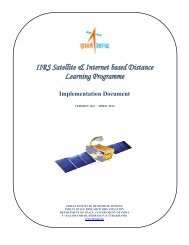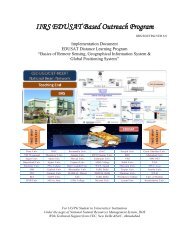Impact of Coal Mining on Vegetation: A Case Study in Jaintia Hills ...
Impact of Coal Mining on Vegetation: A Case Study in Jaintia Hills ...
Impact of Coal Mining on Vegetation: A Case Study in Jaintia Hills ...
You also want an ePaper? Increase the reach of your titles
YUMPU automatically turns print PDFs into web optimized ePapers that Google loves.
IMPACT OF COAL MINING ON VEGETATION: A CASE STUDY IN JAINTIA HILLS DISTRICT OF MEGHALAYA, INDIA5. General Discussi<strong>on</strong> andC<strong>on</strong>clusi<strong>on</strong>s5.1. Discussi<strong>on</strong> and C<strong>on</strong>clusi<strong>on</strong>sJa<strong>in</strong>tia <strong>Hills</strong> district <str<strong>on</strong>g>of</str<strong>on</strong>g> Meghalaya has a total coal deposit <str<strong>on</strong>g>of</str<strong>on</strong>g> about 40 milli<strong>on</strong> t<strong>on</strong>nes. The district hasbeen most extensively exploited for coal. Although <strong>on</strong>ly 7 percent coal deposits are found <strong>in</strong> thedistrict, it c<strong>on</strong>tributes more than 74 percent <str<strong>on</strong>g>of</str<strong>on</strong>g> the total coal producti<strong>on</strong> <strong>in</strong> Meghalaya. The coalfields<str<strong>on</strong>g>of</str<strong>on</strong>g> the Ja<strong>in</strong>tia <strong>Hills</strong> district are small and highly dispersed. <str<strong>on</strong>g>Coal</str<strong>on</strong>g> is mostly found <strong>in</strong> Bapung, Lakad<strong>on</strong>g,Jara<strong>in</strong>-Shkentalang, Lumshn<strong>on</strong>g, Malwar-Musiang-Lamare, Sutnga, Ioksi, Chyrmang and Mutang.The unscientific extracti<strong>on</strong> <str<strong>on</strong>g>of</str<strong>on</strong>g> coal <strong>in</strong> unorganized sector is go<strong>in</strong>g <strong>on</strong> s<strong>in</strong>ce l<strong>on</strong>g and the area affectedby coal m<strong>in</strong><strong>in</strong>g is <strong>in</strong>creas<strong>in</strong>g day by day.Due to extensive coal m<strong>in</strong><strong>in</strong>g, large areas <str<strong>on</strong>g>of</str<strong>on</strong>g> the district have been turned <strong>in</strong>to degraded land, creat<strong>in</strong>gunfavourable habitat c<strong>on</strong>diti<strong>on</strong>s for plants and animals. <str<strong>on</strong>g>M<strong>in</strong><strong>in</strong>g</str<strong>on</strong>g> <str<strong>on</strong>g>of</str<strong>on</strong>g> coal has caused massive damage tothe landscape and biological communities. It was found that the number <str<strong>on</strong>g>of</str<strong>on</strong>g> tree and shrub speciesdecreased due to m<strong>in</strong><strong>in</strong>g. The unfavourable habitat c<strong>on</strong>diti<strong>on</strong>s prevail<strong>in</strong>g <strong>in</strong> the coal-m<strong>in</strong>ed areas havereduced the chances <str<strong>on</strong>g>of</str<strong>on</strong>g> regenerati<strong>on</strong> <str<strong>on</strong>g>of</str<strong>on</strong>g> many a species, thereby reduc<strong>in</strong>g the number <str<strong>on</strong>g>of</str<strong>on</strong>g> species <strong>in</strong> them<strong>in</strong>ed areas. Although the number <str<strong>on</strong>g>of</str<strong>on</strong>g> trees and shrubs have decreased, the number <str<strong>on</strong>g>of</str<strong>on</strong>g> herbaceousspecies col<strong>on</strong>iz<strong>in</strong>g the m<strong>in</strong>ed areas were found to be higher than <strong>in</strong> unm<strong>in</strong>ed areas. Similarobservati<strong>on</strong>s were made by several workers <strong>in</strong> the coal m<strong>in</strong><strong>in</strong>g areas <strong>in</strong> different parts <str<strong>on</strong>g>of</str<strong>on</strong>g> the world(Cornwell, 1971; Fyles et al., 1985; Game et al., 1982; S<strong>in</strong>gh and Jha, 1987; Jha and S<strong>in</strong>gh, 1990).The density <str<strong>on</strong>g>of</str<strong>on</strong>g> tree species decreased c<strong>on</strong>siderably <strong>in</strong> the m<strong>in</strong>ed areas. The density <str<strong>on</strong>g>of</str<strong>on</strong>g> the shrub speciesdid not vary much. Lyngdoh (1995) and Das Gupta (1999) <strong>in</strong> Ja<strong>in</strong>tia <strong>Hills</strong>, and Sarma (2002) <strong>in</strong> Garo<strong>Hills</strong> district <str<strong>on</strong>g>of</str<strong>on</strong>g> the state had similar observati<strong>on</strong>s. This could be due to the better ability <str<strong>on</strong>g>of</str<strong>on</strong>g> herbs toadapt to the disturbed sites. Some herbaceous species <strong>in</strong>vaded the newly created habitats. Nepentheskhasiana was documented from the m<strong>in</strong>ed areas (Figure 5.1). Meghalaya is the <strong>on</strong>ly home for thisendangered species. Due to <strong>in</strong>discrim<strong>in</strong>ate m<strong>in</strong><strong>in</strong>g throughout the district this rare species is highlythreatened.Figure 5.1: The Nepenthes khasiana (pitcher plant), an endangered species, threateneddue to <strong>in</strong>discrim<strong>in</strong>ate m<strong>in</strong><strong>in</strong>g.65



